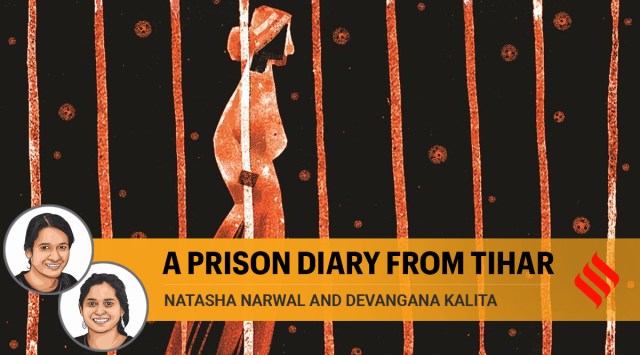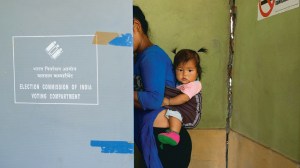- India
- International
A prison diary from Tihar, by Natasha Narwal and Devangana Kalita
🔴 In these times of suffering brought on by the pandemic, it is imperative for the Indian judiciary and the state to ensure the right to life of the people it continues to hold in its custody and not let prisons become graveyards of human rights and dignity.
 Tihar’s women’s prison had witnessed a massive spread of the Covid-19 virus. (C R Sasikumar)
Tihar’s women’s prison had witnessed a massive spread of the Covid-19 virus. (C R Sasikumar)“Aisa lagta hai kabr mein aa gaye hain, na koi awaaz bahar ja sakti hai, na koi awaaz andar aa sakti hai” (It feels like we have entered a grave, no one can hear us and we cannot hear anyone) — a piercing observation made by one of our co-inmates last year, as we lived the deadly second wave of the pandemic inside Tihar’s women’s prison, Jail No.6. With the third wave currently unfolding, urgent attention must be paid to the terrible conditions under which one of the most neglected groups of this country is surviving — India’s prison population. The latest NCRB data tells us that 76 per cent of prisoners are undertrials with a stark overrepresentation of Dalits, Adivasis, Muslims and other minority communities amongst both undertrials and convicts.
 The days of incarceration when the second wave was devastating lives outside and inside, its pain and horror, continue to haunt us. Tihar’s women’s prison witnessed a massive spread of the virus. We watched helplessly as cases emerged from one overcrowded ward after another. We mourned the deaths of our co-inmates far away from their homes. We waited in restless dread for the next day’s five-minute phone call for what news it may bear of our loved ones outside. We began to confront the fear of our own deaths inside that wretched place. On contracting the virus, a prisoner would be shifted to the “Corona ward”, while the barrack where the case was detected would become a “quarantine” barrack for the next 14 days where the inmates inside were locked up 24/7. Since cases kept emerging from every barrack, most of us lived in a state of permanent quarantine. We spent many heart-breaking days and nights listening to the shattering cries of little children when their barrack came to be quarantined.
The days of incarceration when the second wave was devastating lives outside and inside, its pain and horror, continue to haunt us. Tihar’s women’s prison witnessed a massive spread of the virus. We watched helplessly as cases emerged from one overcrowded ward after another. We mourned the deaths of our co-inmates far away from their homes. We waited in restless dread for the next day’s five-minute phone call for what news it may bear of our loved ones outside. We began to confront the fear of our own deaths inside that wretched place. On contracting the virus, a prisoner would be shifted to the “Corona ward”, while the barrack where the case was detected would become a “quarantine” barrack for the next 14 days where the inmates inside were locked up 24/7. Since cases kept emerging from every barrack, most of us lived in a state of permanent quarantine. We spent many heart-breaking days and nights listening to the shattering cries of little children when their barrack came to be quarantined.
Our barrack mate and co-accused, Gulfisha, suffered high fever, severe head and body ache, sleeplessness and loss of appetite. Identified as “symptomatic”, she was put in a tiny suffocating cell with two other inmates. Her Covid was never detected because no RTPCR tests were available — only a limited number of antigen tests were being conducted. Testing kits were in short supply, along with all other equipment such as sanitisers, masks, gloves, PPE suits. Barracks full of symptomatic patients were given a liberal supply of paracetamols, cetirizine, cough syrups and various other drugs through untrained inmates who had to work as paramedics in the absence of a requisite number of trained medical staff.
During the initial days of the outbreak, access to mulaqaats/phone calls/letters/newspapers was terminated. Imagine contracting the virus, being shoved into an overcrowded diseased barrack or a lonely cell all alone, provided negligible medical attention and allowed no contact with your family or friends at a time when you most desperately need it. It was only after the intervention of the Delhi High Court that some of these facilities were resumed inside prison and vaccination of inmates was undertaken. Family and legal mulaqaats in prison have remained suspended through most of the last two years. Even as the facility of e-mulaqaats came to be instituted in August 2020, families of most inmates do not possess smartphones or the digital literacy for accessing the same. Additionally, as a result of courts becoming online and visits by judges or government bodies being discontinued during the pandemic, the impunity that rests in the hands of the jail administration has come to be strengthened. The minimal mechanisms of redressal available to prisoners with regard to discrimination and abuse by prison staff have thus ceased to exist.
Indian prisons have always been overcrowded. In Delhi for example, against a sanctioned prison population of 10,024, the three jails — Tihar, Mandoli and Rohini — have around 19,000-20,000 prisoners. The infrastructure and facilities simply do not exist inside prisons to be able to handle and mitigate a pandemic of this scale. The Supreme Court of India took suo motu cognisance of this issue and on March 23, 2020, issued guidelines for state/UT-wise formation of High Powered Committees (HPC) for the decongestion of prisons. However, the criteria decided by the HPCs of different states for interim release of prisoners, instead of being based on the fundamental principle of equality of all human life, create an arbitrary categorisation of prisoners that deserve to live, based on nature/severity of offence, number of years of sentence but not factors like age, health, comorbidities and other vulnerabilities. So, despite being at “high risk” of mortality, because an undertrial/convict may be charged under certain laws like UAPA, sedition, NDPS or is a foreigner, they are not entitled to interim bail/parole. The online functioning of courts meant that trials couldn’t commence or remained suspended, further prolonging the incarceration for undertrials charged under these sections.

Such unfair criteria in the grant of interim bail are the reason why Father Stan Swamy was not granted bail last year and died in custody, and G N Saibaba, a 90 per cent disabled former Delhi University professor continues to be incarcerated after having contracted Covid once again in Nagpur Jail. These are the names we know but our prisons are filled with hundreds of such undertrials and convicts who are most at risk from the virus but have been denied access to any form of interim relief. Like Elsie, who was from Bolivia and lived in our ward. Despite her co-morbidities, as a foreigner and an NDPS undertrial, she was not eligible for the HPC’s interim bail criteria and died inside prison, thousands of miles away from her two little children whose faces she longed to see. She was put to rest inside prison premises as her family did not have the resources to reclaim her body. Even in death, there was no freedom.
In these times of suffering and despair brought on by the pandemic, it is imperative for the Indian judiciary and the state to ensure the right to life of the people it continues to hold in its custody and not let prisons become graveyards of human rights and dignity.
Narwal is pursuing a PhD in Modern History and Kalita is pursuing an MPhil in Women’s Studies from JNU. Both are Pinjra Tod activists and spent almost 13 months in Tihar jail no.6 charged under UAPA and various other provisions
EXPRESS OPINION
More Explained
Apr 20: Latest News
- 01
- 02
- 03
- 04
- 05









































